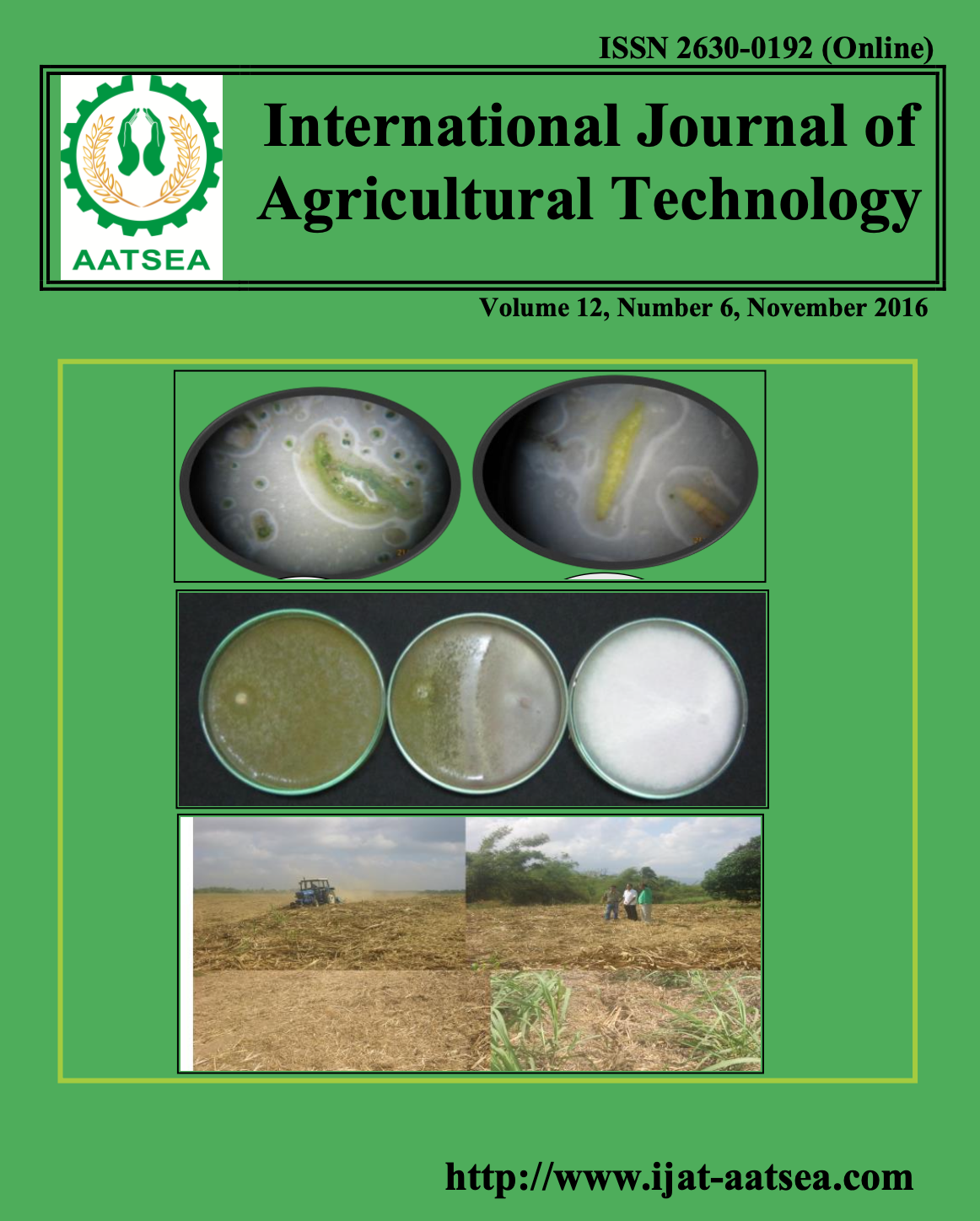Changes of anthocyanins, total phenolic contents and antioxidant activity in black plum (Syzygium cumini Skeels) juice, during local can processing
Main Article Content
Abstract
Changes in anthocyanins, total phenolic content and antioxidant activity in black plum (Syzygium cumini Skeels) juice during local can processing were investigated. Juice samples from four key processing steps (P1: pressing, P2: boiling and filtering the pulps, P3: mixing with sucrose syrup in a ratio of 40:60 (juice:syrup) to produce 40% black plum juice and P4: filtering and pasteurizing) were evaluated total anthocyanins content in term of cyanidin-3-glucoside (Cyd-3-glu), malvidin-3-glucoside (Mvd-3-glu) and pelagonidin-3-glucoside (Pgd-3-glu) by the pH differential method, total phenolic content using Folin-Ciocalteu phenol reagent and antioxidant activity by DPPH assay. The results showed that after black plums were processed, about 88%, 27%, 60% and 154% of total anthocyanins, total phenolics, TEAC and EC50, respectively, were significantly lost (P < 0.05). It could be due to the degradation of anthocyanins during thermal processing, both a long treatment time in boiling step and a short period of time in pasteurization step. Other two anthocyanins; Mvd-3-glu and Pgd-3-glu; were also decreased. In contrast, high temperature treatment increased total phenolic content due to more disruption of cellular membranes and the formation of Maillard reaction products. In addition, there was no significant difference (P > 0.05) of antioxidant activity during the first thermal treatment. However, antioxidant activity significantly decreased at the end of the pasteurization step (P < 0.05). Major loss of all compounds was found in the procedure of juice dilution with sucrose syrup to produce 40% juice. The losses were proportional to their dilution ratio. It was indicated that concentrated juice has more health benefits than diluted juice. So, percentage of juice dilution should be the most important factor for juice consumption. The changes of total anthocyanins content was more correlated with antioxidant activity (r2=0.9708 and 0.9111 for TEAC and EC50, respectively). It could be suggested that anthocyanins played an important role in antioxidant properties in black plum juice more than other phenolic compounds.
Article Details

This work is licensed under a Creative Commons Attribution-NonCommercial-NoDerivatives 4.0 International License.
References
Bhandary, M. J., Chandrashekar, K. R. and Kaveriappa, K. M. (1995). Medical ethnobotany of the Siddis of Uttara Kannada district, Karnataka, India. Journal of Ethnophamacology 47:149-158.
Bourneow, C. and Santimalai, S. (2015). Process optimization for microbial reduction in Durian juice by using pulsed electric field. Proceedings of the Seventh International Conference on Science. Nakhon Pathom and Petchaburi, Thailand. pp. 237-243.
Cocito, C., Gaetano, G. and Delfini, C. (1995). Rapid extraction of aroma compounds in must and wine by means of ultrasound. Food Chemistry 52:311-320.
Cohen, M. F., Sakihama, Y. and Yamasaki, H. (2001). Roles of plant flavonoids in interactions with microbes: from protection against pathogens to mediation of mutualism. Recent research developments in plant physiology 2:157-173.
Corrales, M., Toepfl, S., Butz, P., Knorr, D. and Tauscher, B. (2008). Extraction of anthocyanins from grape by-products assisted by ultrasonics, high hydrostatic pressure or pulsed electric fields: a comparison. Innovative Food Science and Emerging Technologies 9:85-91.
Dini, I., Tenore, G. C. and Dini, A. (2013). Effect of industrial and domestic processing on antioxidant properties of pumpkin pulp. LWT-Food Science and Technology 53:382-385.
Golmohamadi, A., Möller, G., Powers, J. and Nindo, C. (2013). Effect of ultrasound frequency on antioxidant activity, total phenolic and anthocyanin content of red raspberry puree. Ultrasonics Sonochemistry 20:1316-1323.
Gopu, V., Kothandapani, S. and Shetty, P. H. (2015). Quorum quenching activity of Syzygium cumini (L.) Skeels and its anthocyanin malvidin against Klebsiella pneumonia. Microbial Pathogenesis 79:61-69.
Jagetia, G. C. and Baliga, M. S. (2002). Syzygium cumini (Janum) reduces the radiation-induced DNA damage in the cultured human peripheral blood lymphocytes: a preliminary study. Toxicology Letters 132:19-25.
Lee, J., Rennaker, C. and Wrolstad, R. E. (2008). Correlation of two anthocyanin quantification methods: HPLC and spectrophotometric methods. Food Chemistry 110:782-786.
Moldovan, B., David, L., Chişbora, C. and Cimpoiu, C. (2012). Degradation kinetics of anthocyanins from European cranberry bush (Viburnum opulus L.) fruit extracts, effects of temperature, pH and storage solvent. Molecules 17:11655-11666.
Oancea, S. and Oprean, L. (2011). Anthocyanins, from biosynthesis in plants to human health benefits-a review. Acta Universitatis Cibiniensis Series E: Food Technology 15:3-16.
Panyamuangjai, V., Janthara, S., Kusuya, R., Yawootti, R. and Intra, P. (2012). Application of pulsed electric field for milk pasteurization. KMUTT Research and Development Journal 35:469-484.
Patras, A., Brunton, N. P., Da Pieve, S. and Butler, F. (2009). Impact of high pressure processing on total antioxidant activity, phenolic, ascorbic acid, anthocyanin content and colour of strawberry and blackberry purées. Innovative Food Science and Emerging Technologies 10:308-313.
Shimada, K., Fujikawa, K., Yahara, K. and Nakamura, T. (1992). Antioxidative properties of xanthans on the autoxidation of soybean oil in cyclodextrin emulsion. Journal of Agricultural and Food Chemistry 40:945-948.
Tiwari, B. K., Patras, A., Brunton, N., Cullen, P. J. and O’Donnell, C. P. (2010). Effect of ultrasound processing on anthocyanins and color of red grape juice. Ultrasonics Sonochemistry 17:598-604.
Vallverdú-Queralt, A., Medina-Remón, A., Casals-Ribes, I., Andres-Lacueva, C., Waterhouse, A. L. and Lamuela-Raventos, R. M. (2012). Effect of tomato industrial processing on phenolic profile and hydrophilic antioxidant capacity. LWT-Food Science and Technology 47:154-160.
Veigas, J. M., Narayan, M. S., Laxman, P. M. and Neelwarne, B. (2007). Chemical nature, stability and bioefficacies of anthocyanins from fruit peel of Syzygium cumini Skeels. Food Chemistry 105:619-627.
Wong, S. P., Leong, L. P. and Koh, J. H. W. (2006). Antioxidant activities of aqueous extracts of selected plants. Food Chemistry 99:775-783.


